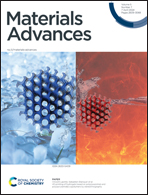Pliable electrode of porous graphene-encapsulated FeNiSe4 binary-metal selenide nanorods as a binder-free anode for lithium-ion batteries†
Abstract
Porous graphene-encapsulated FeNiSe4 binary-metal selenide nanorods (FeNiSe4@PG) were prepared by filtration, annealing, and selenylation techniques. The morphology and structure of FeNiSe4@PG were investigated by scanning electron microscopy (SEM), transmission electron microscopy (TEM), selected area electron diffraction (SAED), and X-ray diffraction (XRD). The interfacial interaction of FeNiSe4 and graphene was characterized using X-ray photoelectron spectroscopy (XPS) and Raman spectroscopy. FeNiSe4@PG exhibited excellent electrochemical performance when used as an anode for lithium-ion batteries. The first reversible capacity of FeNiSe4@PG at 100 mA g−1 was 861.0 mA h g−1 and increased to 1121.6 mA h g−1 after 50 cycles. Even at 1, 2, and 5 A g−1, the specific capacities could still maintain 610.3, 314.1, and 144.4 mA h g−1, even after 500 cycles, respectively. The excellent electrochemical performance of FeNiSe4@PG should be attributed to its special structure. First, the excellent electrical conductivity of graphene improved the overall electrical property of the electrode material. Second, the porous structure of graphene facilitated the infiltration of the electrolyte into the film electrode. Moreover, the synergistic effect of iron and nickel in FeNiSe4@PG and the strong interfacial interaction between graphene and FeNiSe4 contributed to the rapid diffusion of lithium ions and the transport of electrons.



 Please wait while we load your content...
Please wait while we load your content...